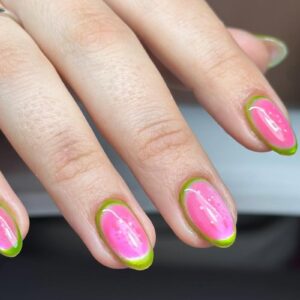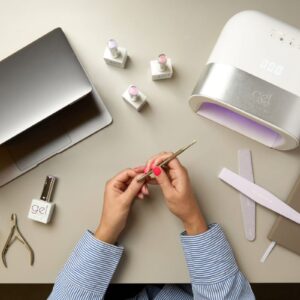
This is why nail primer is so important
By Katie Barnes | 31 January 2017 | Feature, Technique

Salon owner, educator, former Scratch columnist and award-winning nail stylist, Katie Barnes, explores the two types of primer and their importance…
Proper preparation of the nail plate – including the application of primer – can help eliminate service breakdown. Improper use of primer however, could cause skin and nail problems.
Applying too much primer can also affect the strength of the adhesion and over priming with an acid based primer can lead to chemical nail damage and eventually thin the nail plate. Forgetting to prime, or not priming correctly can lead to enhancements lifting or coming off.
A primer, regardless of what industry it’s used in, is designed as a first coat to help a product adhere to another surface. Primers are used in many industries where the application of a coating is involved, such as car paint, wall paint, grout, woodwork and make-up. Primer in the nail industry is designed to help the enhancement adhere to the nail plate.
Which primer should I use?
There are two types of primer that you will come across in the nail industry: acid free and acid based. An acid free primer acts like ‘double sided sticky tape’ and an acid based primer makes tiny microscopic holes in the surface of the nail plate, so the product can ‘weave’ and stick into the nail. If you continuously re-prime the same area with an acid based primer, this is when damage and thinning of the nail plate can occur.
Acid free primer
- Can often be used either instead of acid primer or after acid primer.
- Acts as a double-sided adhesive for gel and acrylic.
- Remains sticky.
- Ensure you apply sparingly, as too much product will decrease adhesive effects.
Acid free primer contains an ingredient that causes a temporary change in the pH of the natural nail (slightly acidic) to make it closer in pH to that of the product (highly alkaline). This pH change helps the product adhere. The nail eventually returns to its natural pH level after around 20 minutes, and the adhesive strength of the primer diminishes so if your L&P application takes longer than this, prime one hand at a time.
Acid primer
- Works by removing excess oils from the nail plate.
- Dries to a chalky finish.
- Most suitable for problematic clients such as those with oily nail plates.
Traditional primer was made with methacrylic acid, which gained a bad reputation due to corrosive properties, so acid based primer was updated, becoming much safer to use on clients with improved adhesion properties. It is important that techs always ensure they only use the minimum amount of either primer required, ensuring it does not touch or flood the skin to avoid skin irritation.
How much primer?
Whether primer is required or how much depends on the specific product application, manufacturer instructions and the condition of the client’s nails. Clients with very oily nail beds and persistent lifting may need a second coat of primer, however it is good practice to go through other possible causes or application problems with your client.
Don’t use primer as a cover for poor application. Services such gel polish, nail polish, silk, and fibreglass do not usually require primer. Conventional L&P will stick to the nails without primer, but it won’t stick very well. Many monomers and base gels now contain primer based properties, so less primer is often required.
When using tips, don’t apply primer on the tips as it can crack the plastic, ensuring you only apply sparingly to the natural nail. It is also important to check the clarity of your primer regularly to ensure that it does not become contaminated with dust, oils etc. as this can affect the effectiveness of the product.
The chemicals that make up primers are similar to the ingredients in L&P and gel enhancement products. It’s just that the final molecule shape has a different structure that enables it to work better as an adhesive product.
Love Katie B x
Image 1: Acid free primer. One end of the primer chain is a perfect match to the nail plate and the other is a perfect match to the monomer and polymer chain.
Image 2: Acid based primer. These dissolve modules of residual oils on the nail plate to allow better adhesion.

Read the latest issue










